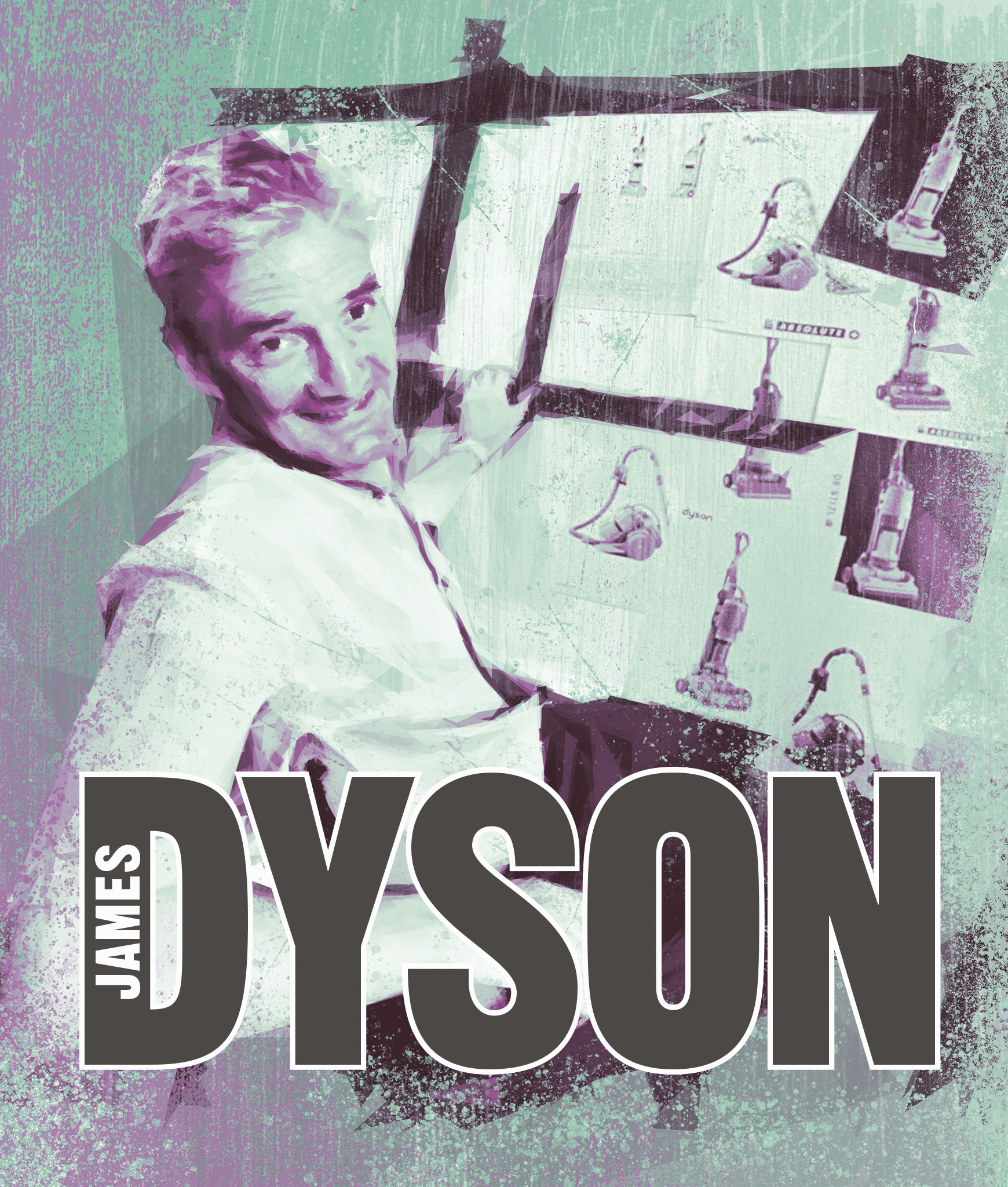
JAMES DYSON
1947–
British inventor James Dyson suffered a series of failures, which put him heavily into debt, before creating his first successful product: a bagless vacuum cleaner with “Cyclone Technology” that became an icon and revolutionized household cleaning. Despite controlling a global company, Dyson’s interest remains focused on innovation.
When he was nine years old, James Dyson’s childhood in Norfolk, England, was rocked by the sudden death of his father. Alec Dyson had been a teacher at a boarding school attended by his son, who stayed on as a pupil after his death. The loss of his father, coupled with living away from home, fostered Dyson’s independence and his determination to prove himself. In his teens, he fell in love with long-distance running, which helped him build the grit and tenacity he later required to perfect his product designs.
After finishing school, Dyson applied to become a doctor, but a medic at the hospital where he was to train suggested he would be more suited to studying art. He transferred to the Byam Shaw School of Art in London, followed by the Royal College of Art, where he developed a passion for design and engineering.
It was here that Dyson met Jeremy Fry. Head of the engineering company Rotork, Fry began to give Dyson freelance design projects and became an inspirational mentor to him. One of these projects, submitted for Dyson’s final-year assessment in 1970, was a prototype for a high-speed, flat-hulled craft that could land without a jetty or harbor. After graduation, Dyson was taken on by Fry to run the subsidiary that designed and sold the landing craft. Four years later, Dyson was ready to set up on his own.
Into business
Dyson’s first attempt at entrepreneurship came in 1974. Frustrated with the wheelbarrow he was using to renovate his home, he devised the Ballbarrow, a wheelbarrow with a plastic ball instead of a wheel, making it easier to maneuver. Having spent all his money on developing the prototype, Dyson needed outside investment to fund production, but he made the mistake of assigning his patent to his new company, Kirk-Dyson, instead of licensing it. He lost control of the company and his design in 1979 when his investors sold the business. Despite this setback, the Ballbarrow led Dyson to his most iconic invention and strengthened his resolve to maintain complete control of all future designs.
“We actually get quite excited when something fails, because that’s how we learn.”
James Dyson, 2007
The vacuum revolution

Dyson had already built an industrial cyclone dust extractor, which used centrifugal force to separate dust from air, for his Ballbarrow factory. The extractor did not need a bag to collect the dust, and in 1978, Dyson realized that this technology could be used in a domestic vacuum cleaner. Exasperated by the dust-clogged bag in his inefficient cleaner at home, Dyson attached a basic cyclone device made out of cardboard and sticky tape onto the machine, and it worked. Dyson spent five years creating more than 5,000 prototypes for a bagless vacuum cleaner; by the time his design was ready, he was almost bankrupt. Unable to find a manufacturer for the cleaner because it would reduce the market for vacuum bags, Dyson was forced to manufacture it himself.
Dyson eventually sold the cleaner—called the G-Force—in Japan, through a catalog company. It proved hugely successful, and in 1991, Dyson used his profits to set up a research center and factory in the Cotswolds, UK. There he developed the DC01 cleaner. It was engineered to maintain a suction so powerful that it could pull cigarette smoke from the air. Dyson quickly patented this “Dual Cyclone” technology, but it was the lack of a vacuum bag that was revolutionary. The DC01 was cleaner, more efficient, and cheaper to run and soon became the most popular vacuum cleaner in the UK. It had been launched in the US by 2001.
Thirst for innovation
Dyson has continued to refine his vacuum cleaner, producing updated models, and to develop a range of new products, including the Airblade hand dryer, hair dryers, fans, and air purifiers.
As well as innovating himself, Dyson set up a charitable foundation in 2002 to support education and research in schools and universities. In 2014, he established the Dyson School of Design Engineering at Imperial College London.

Dyson utilized the Dual Cyclone technology of his bagless vacuum cleaner in his later, improved models as well as in his new products, including a fan that was developed with a cyclone accelerator.
“You are as likely to solve a problem by being unconventional and determined as by being brilliant.”
James Dyson, 2004
NICK GREY

British inventor Nick Grey left his job with only a small amount of savings, but within a year he had founded Grey Technology (Gtech), producing innovative cordless appliances.
Grey (1968–) had no formal engineering education, but just a year after leaving his job as head of product design at vacuum cleaner manufacturer Vax in 2001, he had designed and sold a floor sweeper called the SW01 to US company Shark. It was an instant hit and, unlike the Dyson DC01, cordless. Grey developed other home and garden products, including his biggest seller, the cordless AirRam vacuum cleaner (2012), which uses little electricity compared to other leading machines.
MILESTONES
DISCOVERS DESIGN
Enrolls in furniture design course at the Royal College of Art in 1966, moving into interiors and engineering.
STARTS INNOVATING
In 1974, uses a ball instead of a wheel to create the Ballbarrow, which wins a design innovation award.
DEVELOPS CYCLONE
After five years of refining his Dual Cyclone technology, launches the G-Force vacuum cleaner in 1983.
ESTABLISHES COMPANY
In 1991, founds Dyson Appliances Ltd; its first Dyson vacuum cleaner, the DC01, launches in 1993.
SUPPORTS ENGINEERS
Sets up The James Dyson Foundation in 2002, and in 2007, an annual award, to encourage new designers.
